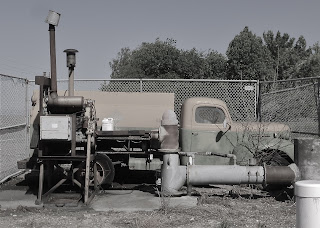…An afternoon with Sonoma’s Vintage Aircraft Company…
The ’42 Boeing Stearman was 10 years
older than myself.
Climbing in (with daughter Jessica) I could not help but
remember that 100 years ago this year, my grandfather (Edgar W. “Hap” Bagnell) landed an
even more primitive machine on the polo field behind the White House in an
effort to impress Congress with the military capabilities of aircraft.
Our flight plan would not take us to DC – and we likely
wouldn’t have lived to tell about it had pilot Chris Prevost attempted a
landing behind the White House.
Located on Arnold Drive near Sonoma,
CA at the Sonoma Valley Airport, the Vintage Aircraft Company offers scenic
flights over the Napa Sonoma Wine County, down to view the San Francisco
skyline and waterfront, or out to the Pacific Coast and Tomales Bay.
Having ridden California’s Highway 1 on the Triumph just a
week ago, I thought it would be interesting to see things from the air, so we
opted for the flight to the coast
The powerful Stearman fueled and
eager to slip the surly bonds of earth, Jessica pulled together her best
impersonation of Amelia Earhart prior to wheels up.
Settling into the forward compartment, a glimpse at the
instrument panel exposed how far we’ve come since Hap flew. This ain’t no Southwest 737-800.
Lifting off, we were soon bearing west across US 101 near
Petaluma toward Two Rock tracing, I think, Tomales Petaluma Road. I hoped to tell my seatmate I just
driven that lovely, pastoral route on the T-bird, but the roar of the big Pratt
and Whitney pushed the words back
down my throat. All I could do was
point.
I also found that when I placed my Panasonic camera just
above the windscreen, I couldn’t get the shutter to operate, thus, no pictures
from directly over the engine. Then
again, no bug splats on the lens…
Later, I determined that I should simply pocket the camera
and enjoy the flight, which is what I’ll do next time. From the still air of the forward
cockpit, I did fire off a selfie of sorts…
The open-air cockpit left little doubt when we entered into
the marine layer lapping over the coastline. Glad I was that the purveyors of this trip offered – and I
accepted – a fleece layer for the journey.
Short of Dillon Beach, at the mouth of Tomales Bay, we bore
south atop the San Andrea Rift Zone.
Again I pointed and attempted:
“Pacific Plate over there. North
American Plate over there…”
Jessica didn’t need to hear that. Why must I always be the
Answer Man?
The pass south over Tomales Bay, at – what did the gauge
say, 110 knots? – went too quickly, but that was on me.
I missed some ground points I was looking for as I fumbled with my
camera. Marshall. Inverness. There were things I’d seen from State Route 1 that I wanted
to see from the air…
Banking eastward, the ambient temperature rose and we paralleled
the northern reach of San Pablo Bay lay to the south. A fingernail of the San Francisco skyline melted into the
haze.
Soon we found ourselves circling the airfield and preparing
to land.
After touching down like a feather,
Pilot Prevost taxied between the hangars and, for an added entertainment bonus,
somehow used forward braking to back us into the big Stearman’s resting
spot.
Passers-by from Dubai who’d
just ridden up on rented Harleys expressed awe.
I, however, had been awestruck by the whole thing.
The adventure had been a gift from my altitude challenged
wife, something I wish I could have shared with her, but sharing it with
daughter Jessica made the whole event memorable times three.
Jessica, me...
...and Hap
o0o
Check out Vintage Aircraft Company at http://www.vintageaircraft.com/ and
give some thought to scheduling a flight with ‘em.
© 2017
Church of the Open Road Press

















































